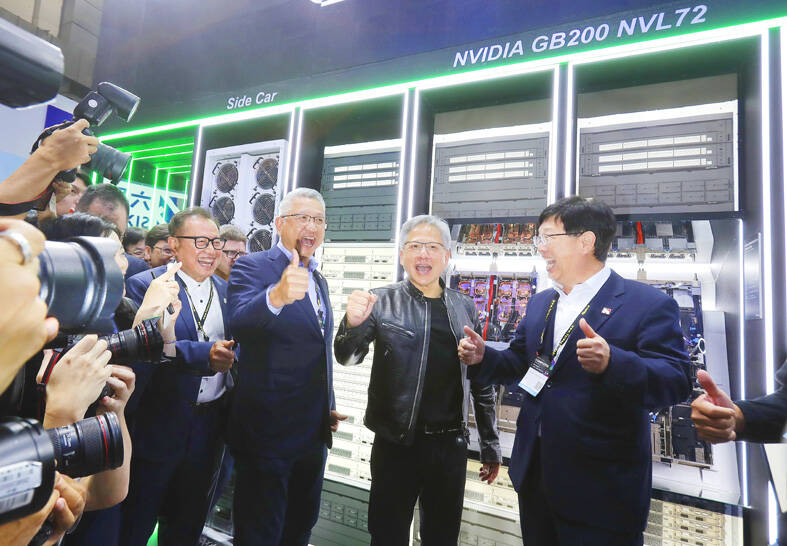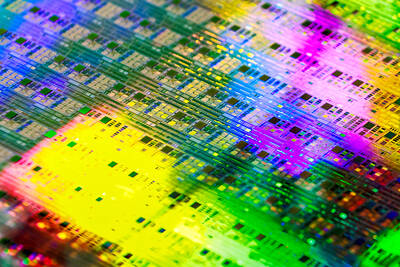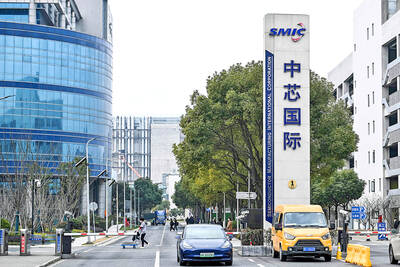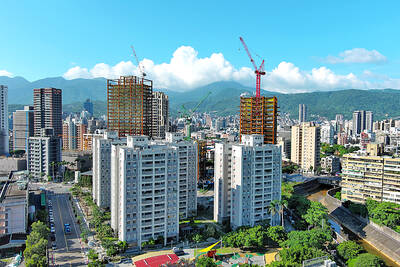Hon Hai Precision Industry Co (鴻海精密) yesterday said artificial intelligence (AI) server revenue this quarter is to more than double from a year ago, driven by demand for AI servers based on Nvidia’s GB200 chip from the world’s major cloud service providers (CSP) and large-scale enterprises.
The growth momentum is expected to extend into the rest of the year, Hon Hai said. This year as a whole, revenue from AI servers would swell to about NT$1 trillion, following an annual growth of 150 percent last year, company chairman Young Liu (劉揚偉) told investors during an online investor conference.
That meant AI server revenue would account for more than 50 percent of the company’s overall server revenue this year, up from 40 percent to 42 percent last year, Liu said.

Photo: Chiang Ying-ying, AP
Servers and networking products would soon become the largest revenue contributor to Hon Hai, replacing smartphones, he said.
“The AI server market is thriving now, thanks to strong demand for GB server racks from the world’s major CSPs and first-tier brand vendors. Those [machines] are adopted particularly for cloud computing and high-performance data centers,” Liu said, citing better order visibility.
Hon Hai is also ramping up production of GB200 servers with an improving yield, Liu said, adding that the growth momentum would be supported by the upcoming production of AI servers equipped with new-generation AI chips, he said.
As a key supplier to Nvidia, Hon Hai aims to seize more than 40 percent of the world’s AI server market, Liu said.
Liu also dismissed rumors about ebbing demand for AI servers from cloud service providers (CSPs).
“There was a rumor saying that CSP demand will peak this year. And then, it will go down after this year. We are not seeing that. We think the demand is still pretty strong,” at least for Hon Hai, Liu said.
Asked about growing competition from servers powered by AI application-specific ICs (ASICs), Liu said: “Most of the training still happens in the cloud side, so most activities on the AI demand is mostly still for AI training.”
Looking at the current quarter, Hon Hai expects revenue to grow significantly on an annual basis, beating the seasonal slowdown the company has seen over the past 5 years, Liu said.
All major product segments are expected to see strong year-on-year growth this quarter, led by servers and networking products, Liu said.
Asked about how to cope with US President Donald Trump’s tariff policy, Liu said Hon Hai is discussing with its customers to build new manufacturing sites in the US.
To fund those new factories, Hon Hai plans to hike its capital expenditures this year by 20 percent from NT$136.3 billion last year. The company said it would discuss with customers to absorb cost increases in order to keep a stable profit margin.
Hon Hai yesterday posted the strongest annual net profit in the company’s history, amounting to NT$152.71 billion, up 7 percent from NT$142.1 billion in 2023. Earnings per share rose to NT$11.01 from NT$10.25, the highest since 2008.
The board of directors yesterday approved a cash dividend distribution of NT$5.8 per common share, the best since the company’s listing in 1991. That represented a payout ratio of 52.7 percent.

NO BREAKTHROUGH? More substantial ‘deliverables,’ such as tariff reductions, would likely be saved for a meeting between Trump and Xi later this year, a trade expert said China launched two probes targeting the US semiconductor sector on Saturday ahead of talks between the two nations in Spain this week on trade, national security and the ownership of social media platform TikTok. China’s Ministry of Commerce announced an anti-dumping investigation into certain analog integrated circuits (ICs) imported from the US. The investigation is to target some commodity interface ICs and gate driver ICs, which are commonly made by US companies such as Texas Instruments Inc and ON Semiconductor Corp. The ministry also announced an anti-discrimination probe into US measures against China’s chip sector. US measures such as export curbs and tariffs

The US on Friday penalized two Chinese firms that acquired US chipmaking equipment for China’s top chipmaker, Semiconductor Manufacturing International Corp (SMIC, 中芯國際), including them among 32 entities that were added to the US Department of Commerce’s restricted trade list, a US government posting showed. Twenty-three of the 32 are in China. GMC Semiconductor Technology (Wuxi) Co (吉姆西半導體科技) and Jicun Semiconductor Technology (Shanghai) Co (吉存半導體科技) were placed on the list, formally known as the Entity List, for acquiring equipment for SMIC Northern Integrated Circuit Manufacturing (Beijing) Corp (中芯北方積體電路) and Semiconductor Manufacturing International (Beijing) Corp (中芯北京), the US Federal Register posting said. The

India’s ban of online money-based games could drive addicts to unregulated apps and offshore platforms that pose new financial and social risks, fantasy-sports gaming experts say. Indian Prime Minister Narendra Modi’s government banned real-money online games late last month, citing financial losses and addiction, leading to a shutdown of many apps offering paid fantasy cricket, rummy and poker games. “Many will move to offshore platforms, because of the addictive nature — they will find alternate means to get that dopamine hit,” said Viren Hemrajani, a Mumbai-based fantasy cricket analyst. “It [also] leads to fraud and scams, because everything is now

MORTGAGE WORRIES: About 34% of respondents to a survey said they would approach multiple lenders to pay for a home, while 29.2% said they would ask family for help New housing projects in Taiwan’s six special municipalities, as well as Hsinchu city and county, are projected to total NT$710.65 billion (US$23.61 billion) in the upcoming fall sales season, a record 30 percent decrease from a year earlier, as tighter mortgage rules prompt developers to pull back, property listing platform 591.com (591新建案) said yesterday. The number of projects has also fallen to 312, a more than 20 percent decrease year-on-year, underscoring weakening sentiment and momentum amid lingering policy and financing headwinds. New Taipei City and Taoyuan bucked the downturn in project value, while Taipei, Hsinchu city and county, Taichung, Tainan and Kaohsiung